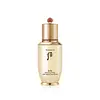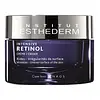What's inside
What's inside
 Key Ingredients
Key Ingredients

 Benefits
Benefits

 Concerns
Concerns

 Ingredients Side-by-side
Ingredients Side-by-side

Water
Skin ConditioningGlycerin
HumectantDipropylene Glycol
HumectantPEG/PPG/Polybutylene Glycol-8/5/3 Glycerin
HumectantGlyceryl Polymethacrylate
Biosaccharide Gum-1
HumectantDimethicone
Emollient1,2-Hexanediol
Skin ConditioningPEG-150
HumectantMethyl Trimethicone
Skin ConditioningPanthenol
Skin ConditioningPhenyl Trimethicone
Skin ConditioningPropylene Glycol
HumectantCyclopentasiloxane
EmollientPolymethylsilsesquioxane
Hydrogenated Lecithin
EmulsifyingHydroxyproline
Skin ConditioningC14-22 Alcohols
Emulsion StabilisingSqualane
EmollientPanax Ginseng Root Extract
EmollientOphiopogon Japonicus Root Extract
Skin ConditioningPEG-60 Hydrogenated Castor Oil
EmulsifyingButylene Glycol
HumectantCeramide NP
Skin ConditioningRehmannia Glutinosa Root Extract
Skin ConditioningAngelica Acutiloba Root Extract
Skin ConditioningCornus Officinalis Fruit Extract
Skin ConditioningNelumbo Nucifera Flower Extract
Skin ConditioningNelumbo Nucifera Root Extract
Skin ConditioningThymus Vulgaris Extract
PerfumingVelvet Extract
HumectantTromethamine
BufferingMacadamia Ternifolia Seed Oil
EmollientTriethylhexanoin
MaskingCarbomer
Emulsion StabilisingDimethiconol
EmollientDioscorea Japonica Root Extract
Skin ConditioningGlycyrrhiza Glabra Root Extract
BleachingPEG-10 Rapeseed Sterol
CleansingArachidyl Glucoside
EmulsifyingButyrospermum Parkii Butter
Skin ConditioningParfum
MaskingAlgin
MaskingSodium Polyacrylate
AbsorbentTypha Angustifolia Spike Extract
Skin ConditioningCinnamomum Cassia Bark Extract
MaskingPaeonia Albiflora Root Extract
Skin ConditioningGlyceryl Stearate
EmollientScutellaria Baicalensis Root Extract
AstringentAcrylates/C10-30 Alkyl Acrylate Crosspolymer
Emulsion StabilisingAtractylodes Japonica Rhizome Extract
Skin ConditioningSaposhnikovia Divaricata Root Extract
AntimicrobialZingiber Officinale Root Extract
MaskingZiziphus Jujuba Fruit Extract
Skin ConditioningStearic Acid
CleansingAngelica Gigas Root Extract
Skin ConditioningCholesterol
EmollientPEG-100 Stearate
Beta-Glucan
Skin ConditioningGlycereth-20
HumectantPoria Cocos Extract
Skin ConditioningTheobroma Cacao Extract
Skin ConditioningTrisodium EDTA
Cordyceps Sinensis Extract
AntioxidantCI 15985
Cosmetic ColorantCI 19140
Cosmetic ColorantArbutin
AntioxidantGlycosphingolipids
EmollientOligopeptide-1
Skin ConditioningOligopeptide-4
Skin ConditioningPhospholipids
Skin ConditioningAcetyl Hexapeptide-8
HumectantCopper Tripeptide-1
Skin ConditioningHydrolyzed Soy Protein
HumectantOligopeptide-2
Skin ConditioningHistidine Hcl
Skin ConditioningArginine
MaskingLysine
Skin ConditioningValine
MaskingThreonine
Leucine
Skin ConditioningMethionine
Skin ConditioningIsoleucine
Skin ConditioningPhenylalanine
MaskingTyrosine
MaskingInositol
HumectantCystine
MaskingTryptophan
MaskingFolic Acid
Skin ConditioningNiacinamide
SmoothingPyridoxine Hcl
Skin ConditioningThiamine Hcl
MaskingCalcium Pantothenate
Biotin
AntiseborrhoeicRiboflavin
Cosmetic ColorantCyanocobalamin
Skin ConditioningWater, Glycerin, Dipropylene Glycol, PEG/PPG/Polybutylene Glycol-8/5/3 Glycerin, Glyceryl Polymethacrylate, Biosaccharide Gum-1, Dimethicone, 1,2-Hexanediol, PEG-150, Methyl Trimethicone, Panthenol, Phenyl Trimethicone, Propylene Glycol, Cyclopentasiloxane, Polymethylsilsesquioxane, Hydrogenated Lecithin, Hydroxyproline, C14-22 Alcohols, Squalane, Panax Ginseng Root Extract, Ophiopogon Japonicus Root Extract, PEG-60 Hydrogenated Castor Oil, Butylene Glycol, Ceramide NP, Rehmannia Glutinosa Root Extract, Angelica Acutiloba Root Extract, Cornus Officinalis Fruit Extract, Nelumbo Nucifera Flower Extract, Nelumbo Nucifera Root Extract, Thymus Vulgaris Extract, Velvet Extract, Tromethamine, Macadamia Ternifolia Seed Oil, Triethylhexanoin, Carbomer, Dimethiconol, Dioscorea Japonica Root Extract, Glycyrrhiza Glabra Root Extract, PEG-10 Rapeseed Sterol, Arachidyl Glucoside, Butyrospermum Parkii Butter, Parfum, Algin, Sodium Polyacrylate, Typha Angustifolia Spike Extract, Cinnamomum Cassia Bark Extract, Paeonia Albiflora Root Extract, Glyceryl Stearate, Scutellaria Baicalensis Root Extract, Acrylates/C10-30 Alkyl Acrylate Crosspolymer, Atractylodes Japonica Rhizome Extract, Saposhnikovia Divaricata Root Extract, Zingiber Officinale Root Extract, Ziziphus Jujuba Fruit Extract, Stearic Acid, Angelica Gigas Root Extract, Cholesterol, PEG-100 Stearate, Beta-Glucan, Glycereth-20, Poria Cocos Extract, Theobroma Cacao Extract, Trisodium EDTA, Cordyceps Sinensis Extract, CI 15985, CI 19140, Arbutin, Glycosphingolipids, Oligopeptide-1, Oligopeptide-4, Phospholipids, Acetyl Hexapeptide-8, Copper Tripeptide-1, Hydrolyzed Soy Protein, Oligopeptide-2, Histidine Hcl, Arginine, Lysine, Valine, Threonine, Leucine, Methionine, Isoleucine, Phenylalanine, Tyrosine, Inositol, Cystine, Tryptophan, Folic Acid, Niacinamide, Pyridoxine Hcl, Thiamine Hcl, Calcium Pantothenate, Biotin, Riboflavin, Cyanocobalamin
Glycerin
HumectantCetearyl Isononanoate
EmollientCyclopentasiloxane
EmollientPropylene Glycol Dicaprate
EmollientDipropylene Glycol
HumectantPalmitamide DEA
Cetyl Palmitate
EmollientCetearyl Glucoside
EmulsifyingSqualane
EmollientC30-45 Alkyl Cetearyl Dimethicone Crosspolymer
EmollientRetinyl Palmitate
Skin ConditioningPolysorbate 60
EmulsifyingParfum
MaskingPentaerythrityl Tetra-Di-T-Butyl Hydroxyhydrocinnamate
AntioxidantSorbitan Isostearate
EmulsifyingCarnosine
Skin ConditioningTocopherol
AntioxidantLaminaria Digitata Extract
Skin ProtectingGlycerin, Cetearyl Isononanoate, Cyclopentasiloxane, Propylene Glycol Dicaprate, Dipropylene Glycol, Palmitamide DEA, Cetyl Palmitate, Cetearyl Glucoside, Squalane, C30-45 Alkyl Cetearyl Dimethicone Crosspolymer, Retinyl Palmitate, Polysorbate 60, Parfum, Pentaerythrityl Tetra-Di-T-Butyl Hydroxyhydrocinnamate, Sorbitan Isostearate, Carnosine, Tocopherol, Laminaria Digitata Extract
Ingredients Explained
These ingredients are found in both products.
Ingredients higher up in an ingredient list are typically present in a larger amount.
Cyclopentasiloxane, or D5, is a silicone used to improve texture of products and trap moisture.
D5 is considered lightweight and volatile. Volatile means it evaporates quickly after application. Once evaporated, D5 leaves a thin barrier that helps keep skin hydrated.
It is also an emollient. Emollients help soften the skin and prevent water loss. Silicones create a silky texture in products. D5 helps other ingredients become more spreadable.
Studies show D5 is safe to use in skincare products. We recommend speaking with a skincare professional if you have concerns.
Learn more about CyclopentasiloxaneDipropylene Glycol is a synthetically created humectant, stabilizer, and solvent.
This ingredient helps:
Dipropylene glycol is technically an alcohol, but it belongs to the glycol family (often considered part of the ‘good’ alcohols). This means it is hydrating and gentle on skin unlike drying solvent alcohols like denatured alcohol.
As a masking agent, Dipropylene Glycol can be used to cover the smell of other ingredients. However, it does not have a scent.
Studies show Dipropylene Glycol is considered safe to use in skincare.
Learn more about Dipropylene GlycolGlycerin is already naturally found in your skin. It helps moisturize and protect your skin.
A study from 2016 found glycerin to be more effective as a humectant than AHAs and hyaluronic acid.
As a humectant, it helps the skin stay hydrated by pulling moisture to your skin. The low molecular weight of glycerin allows it to pull moisture into the deeper layers of your skin.
Hydrated skin improves your skin barrier; Your skin barrier helps protect against irritants and bacteria.
Glycerin has also been found to have antimicrobial and antiviral properties. Due to these properties, glycerin is often used in wound and burn treatments.
In cosmetics, glycerin is usually derived from plants such as soybean or palm. However, it can also be sourced from animals, such as tallow or animal fat.
This ingredient is organic, colorless, odorless, and non-toxic.
Glycerin is the name for this ingredient in American English. British English uses Glycerol/Glycerine.
Learn more about GlycerinParfum is a catch-all term for an ingredient or more that is used to give a scent to products.
Also called "fragrance", this ingredient can be a blend of hundreds of chemicals or plant oils. This means every product with "fragrance" or "parfum" in the ingredients list is a different mixture.
For instance, Habanolide is a proprietary trade name for a specific aroma chemical. When used as a fragrance ingredient in cosmetics, most aroma chemicals fall under the broad labeling category of “FRAGRANCE” or “PARFUM” according to EU and US regulations.
The term 'parfum' or 'fragrance' is not regulated in many countries. In many cases, it is up to the brand to define this term.
For instance, many brands choose to label themselves as "fragrance-free" because they are not using synthetic fragrances. However, their products may still contain ingredients such as essential oils that are considered a fragrance by INCI standards.
One example is Calendula flower extract. Calendula is an essential oil that still imparts a scent or 'fragrance'.
Depending on the blend, the ingredients in the mixture can cause allergies and sensitivities on the skin. Some ingredients that are known EU allergens include linalool and citronellol.
Parfum can also be used to mask or cover an unpleasant scent.
The bottom line is: not all fragrances/parfum/ingredients are created equally. If you are worried about fragrances, we recommend taking a closer look at an ingredient. And of course, we always recommend speaking with a professional.
Learn more about ParfumSqualane is an emollient that helps the skin hold onto moisture. It's an oily liquid that occurs naturally in certain types of fish and plant oils.
Because squalane boosts hydration in the skin, it also comes with plenty of benefits: it is an antioxidant and can help fight free radicals and skin damage. Squalane is also found to have a detoxifying effect when applied.
Squalane comes from squalene, which occurs naturally within the sebum of our skin. It is one of the oils our skin produces to keep itself hydrated. Squalane is the hydrogenated version of squalene and has a longer shelf life.
Research shows that squalane is non-irritating (even at 100% concentration).
In general, it's a fantastic ingredient. It does a great job at hydrating the skin, and it's suitable for those with sensitive skin.
The source of squalane may impact malassezia / fungal acne. This is because olive oil derived squalane can contain impurities such as fatty acids and plant waxes. Sugarcane derived squalane is recommended for anyone with malassezia concerns.
Is squalane vegan?
This depends on the source. Squalane can be derived from both plants and animals. Most squalane used in skincare comes from plants.
Please note: the source of squalane is only known if disclosed by the brand. We recommend reaching out to the brand if you have any questions about their squalane.
Read more about squalene with an "e".
Is squalane an oil?
Squalane is often called an oil, but it’s technically not; it’s a hydrocarbon, meaning it’s only made of carbon and hydrogen, unlike true oils which are triglycerides made of fatty acids and glycerol.
The term “oil-free” isn’t regulated, so companies can define it however they want. Some exclude all oils, while others just avoid mineral oil or comedogenic oils.
While some people avoid oils thinking they cause breakouts, the right kind of oil (or oil-like ingredient like squalane) can actually help balance and hydrate your skin. It’s worth testing out simple oils or squalane to see what works best for your skin.
Learn more about Squalane